Theoretical Study of Liquid Flow and Temperature Distribution in OF-Cooled Power Transformers
Abstract
:1. Introduction
2. Liquid Flow and Temperature Distribution in OF-Cooled Power Transformers
3. Simple Winding Geometry Simulations
3.1. Case Description
3.2. CFD Modelling and Solution Procedure
3.3. Mathematical Model Based on the Thermo-Hydraulic Network Modelling Approach
- The pressure drop due to hydraulic resistance of the by-pass flow path is much smaller than the pressure drop due to hydraulic resistance in the windings.
- The temperature of the liquid above and below the windings is uniform.
- The by-pass liquid temperature below the top of the windings equals the bottom-liquid temperature.
- The liquid properties are determined based on average temperatures for every flow path.
3.4. Results
4. Complex Winding Geometry
Case and Calculation Description
- The heat transfer coefficient in the cooling channels of the windings is calculated using equations for the Nusselt number, which are valid for laminar flow between parallel plates with constant heat flux. The equations can be found in Ref. [13].
- The pressure drop coefficient is calculated using equations valid for hydraulically developing laminar flow between parallel plates. The equations can be found in Ref. [13].
- Local pressure drops in the windings and in the insulation system below and above the windings are neglected.
5. Conclusions
Author Contributions
Funding
Data Availability Statement
Conflicts of Interest
References
- IEC 60076-2:2011; Power Transformers—Part 2: Temperature Rise for Liquid-Immersed Transformers. IEC: Geneva, Switzerland, 2011.
- Yamaguchi, M.; Kumasaka, T.; Inui, Y.; Ono, S. The flow rate in a self-cooled transformer. IEEE Trans. Power Appar. Syst. 1981, PAS-100, 956–963. [Google Scholar] [CrossRef]
- Karsai, K.; Kerényi, D.; Kiss, L. Large Power Transformers; Elsevier: Amsterdam, The Netherlands, 1987. [Google Scholar]
- Sorgic, M.; Radakovic, Z. Oil-Forced Versus Oil-Directed Cooling of Power Transformers. IEEE Trans. Power Deliv. 2010, 25, 2590–2598. [Google Scholar] [CrossRef]
- Godec, Z.; Šarunac, R. Steady-state temperature rises of ONAN/ONAF/OFAF transformers. IEE Proc. C Gener. Transm. Distrib. 1992, 139, 448–454. [Google Scholar] [CrossRef]
- Convenor, J.L. Transformer Thermal Modelling; Working Group A2.38; CIGRE Publication: Paris, France, 2016. [Google Scholar]
- Radakovic, Z.R.; Sorgic, M.S. Basics of Detailed Thermal-Hydraulic Model for Thermal Design of Oil Power Transformers. IEEE Trans. Power Deliv. 2010, 25, 790–802. [Google Scholar] [CrossRef]
- Zhang, J.; Li, X. Analysis for Oil Thermosyphon Circulation and Winding Temperature in ON Transformers. In Proceedings of the 2007 IEEE Power Engineering Society General Meeting, Tampa, FL, USA, 24–28 June 2007; pp. 1–8. [Google Scholar]
- IEC 60076-7:2018; Power Transformers—Part 7: Loading Guide for Mineral-Oil-Immersed Power Transformers. IEC Standard: Geneva, Switzerland, 2018.
- Vecchio, R.M.D.; Poulin, B.; Feghali, P.T.; Shah, D.M.; Ahuja, R. Transformer Design Principles: With Applications to Core-Form Power Transformers; CRC Press/Taylor & Francis Group: London, UK, 2001. [Google Scholar]
- ANSYS. Fluent User’s Guide Release 2022 R1 January 2022; ANSYS Inc.: Canonsburg, PA, USA, 2022. [Google Scholar]
- Oliver, A. Estimation of transformer winding temperatures and coolant flows using a general network method. IEE Proc. C Gener. Transm. Distrib. 1980, 127, 395–405. [Google Scholar] [CrossRef]
- Shah, R.K.; London, A.L. Laminar Flow Forced Convection in Ducts: A Source Book for Compact Heat Exchanger Analytical Data; Academic Press: New York, NY, USA, 1978. [Google Scholar]
- Susa, D.; Lehtonen, M.; Nordman, H. Dynamic Thermal Modelling of Power Transformers. IEEE Trans. Power Deliv. 2005, 20, 197–204. [Google Scholar] [CrossRef]
- Zhang, X.; Wang, Z.; Lui, Q.; Jarman, P.; Gyore, A.; Dyer, P. Numerical Investigation of Influences of Coolant Types on Flow Distribution and Pressure Drop in Disc Type Transformer Windings. In Proceedings of the International Conference on Condition Monitoring and Diagnosis CMD, Xi’an, China, 25–28 September 2016; pp. 52–55. [Google Scholar] [CrossRef]
- Daghrah, M.; Wang, Z.; Liu, Q.; Hilker, A.; Gyore A., A. Experimental Study of the Influence of Different Liquids on the Transformer Cooling Performance. IEEE Trans. Power Deliv. 2019, 34, 588–595. [Google Scholar] [CrossRef]
- Midel 7131: Thermal Properties. Available online: https://www.midel.com/app/uploads/2018/09/MIDEL_7131_Thermal_Properties.pdf (accessed on 18 December 2023).
- Plaznik, U.; Klobučar, L.; Prašnikar, B. Thermal design of ester filled power transformers. In Proceedings of the 41. CIGRE International Symposium, Ljubljana, Slovenia, 21–24 November 2021; p. 1194. [Google Scholar]


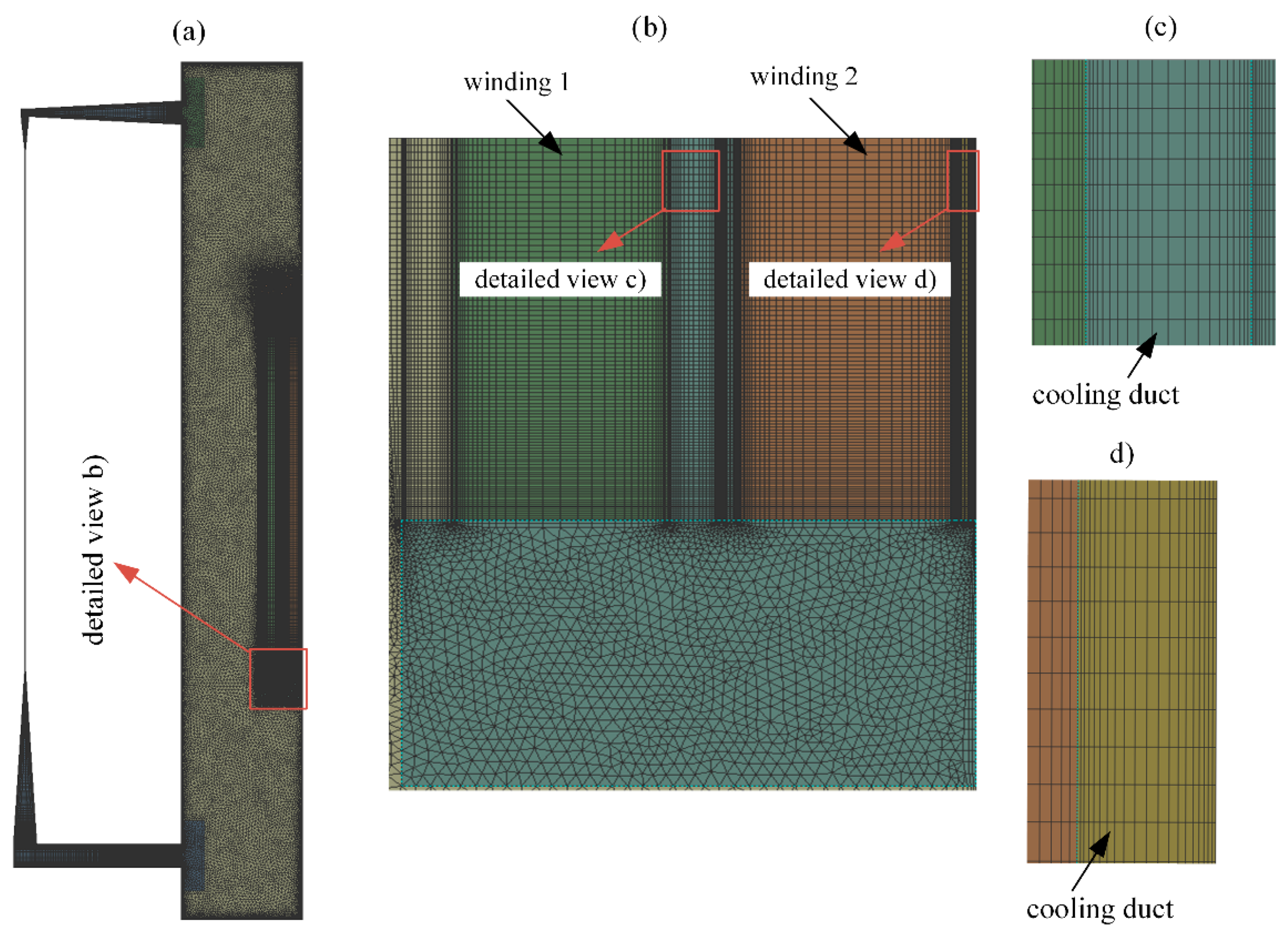
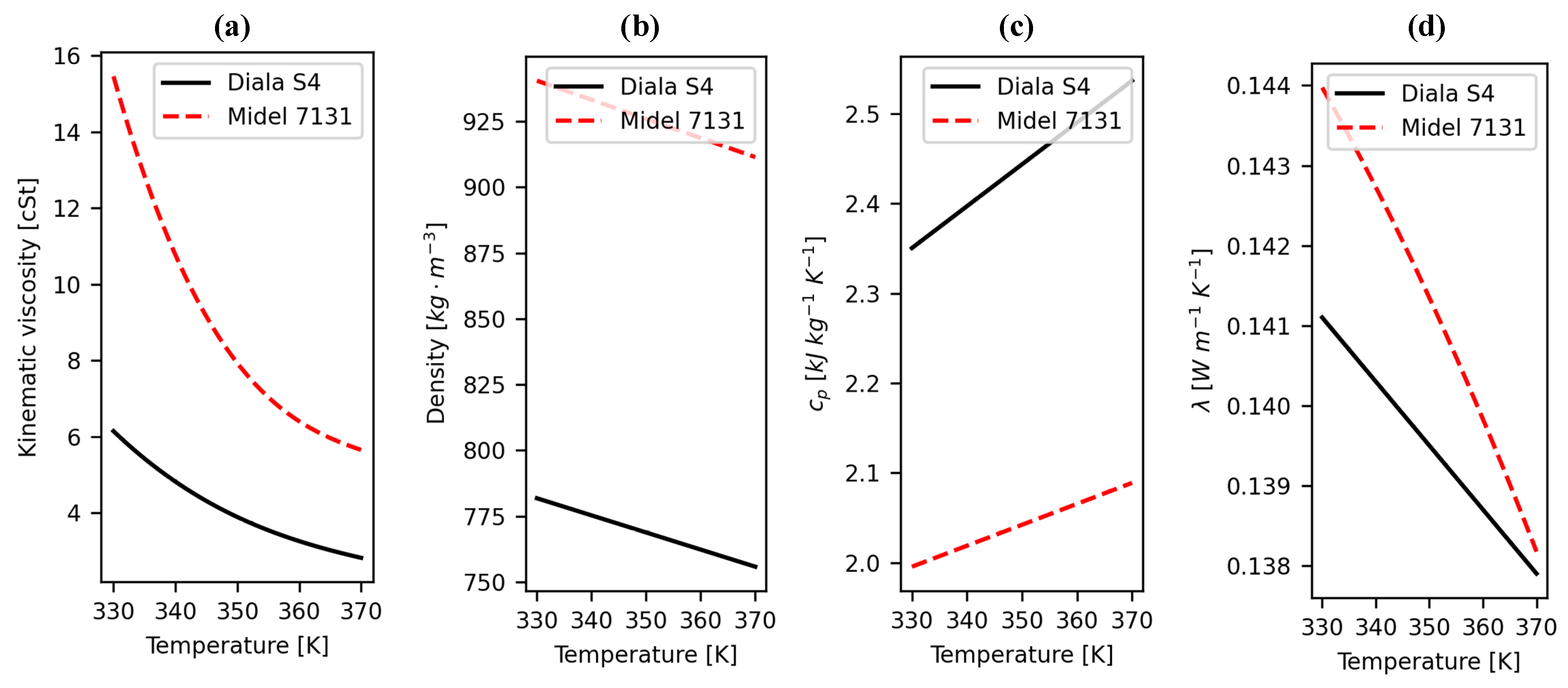


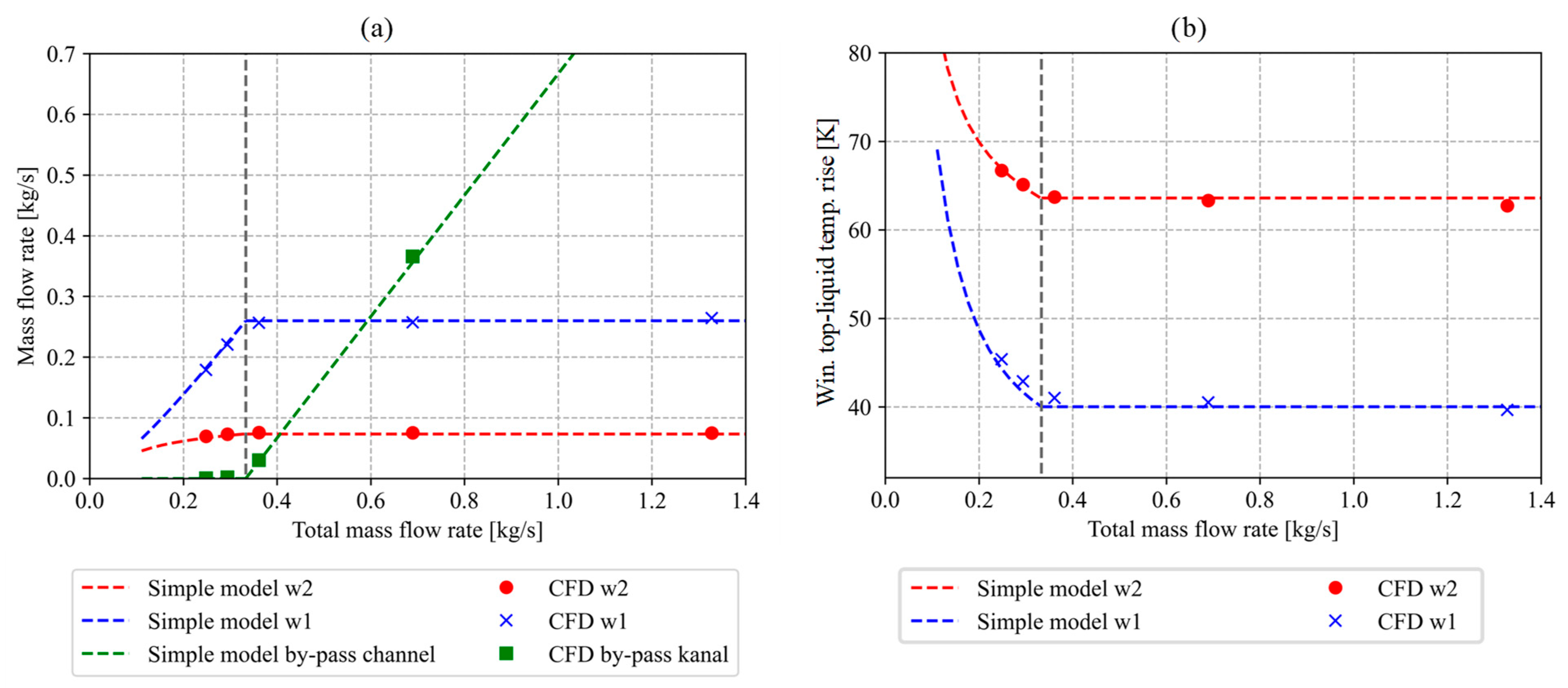
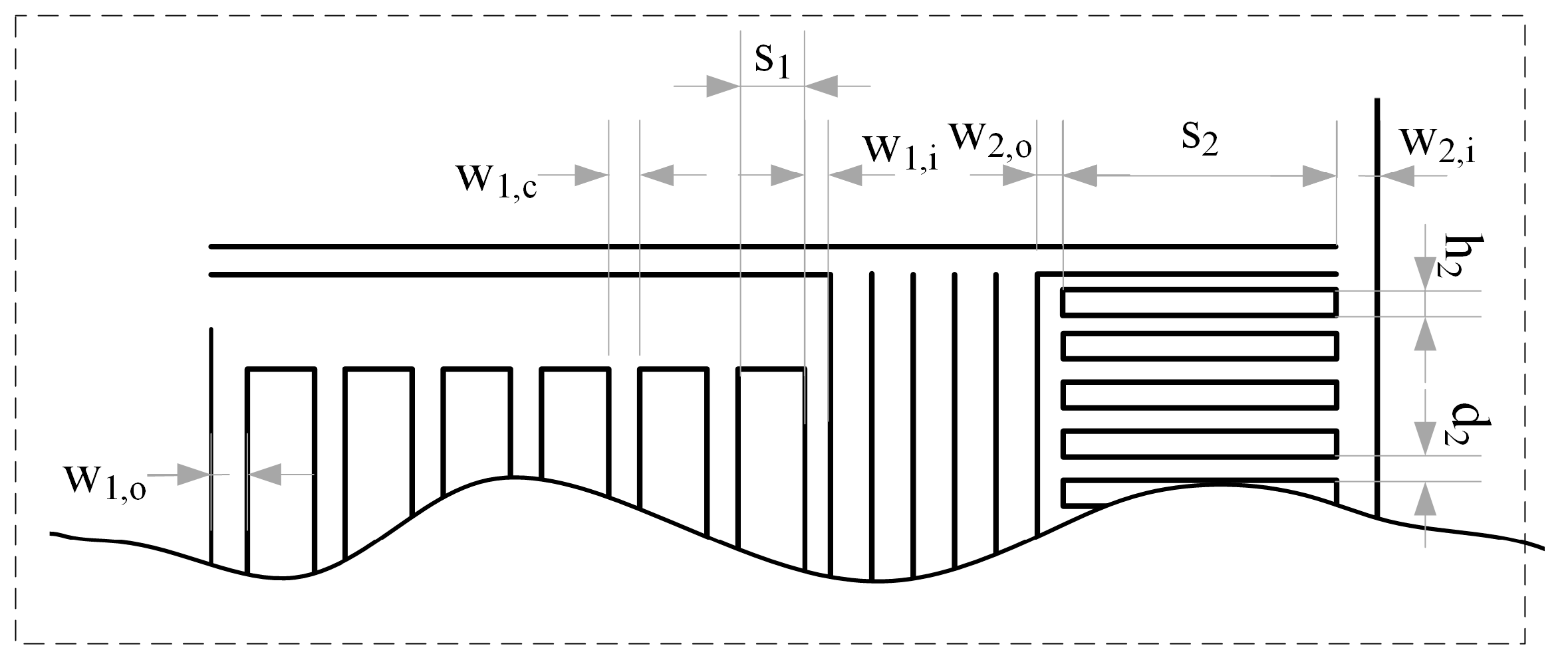
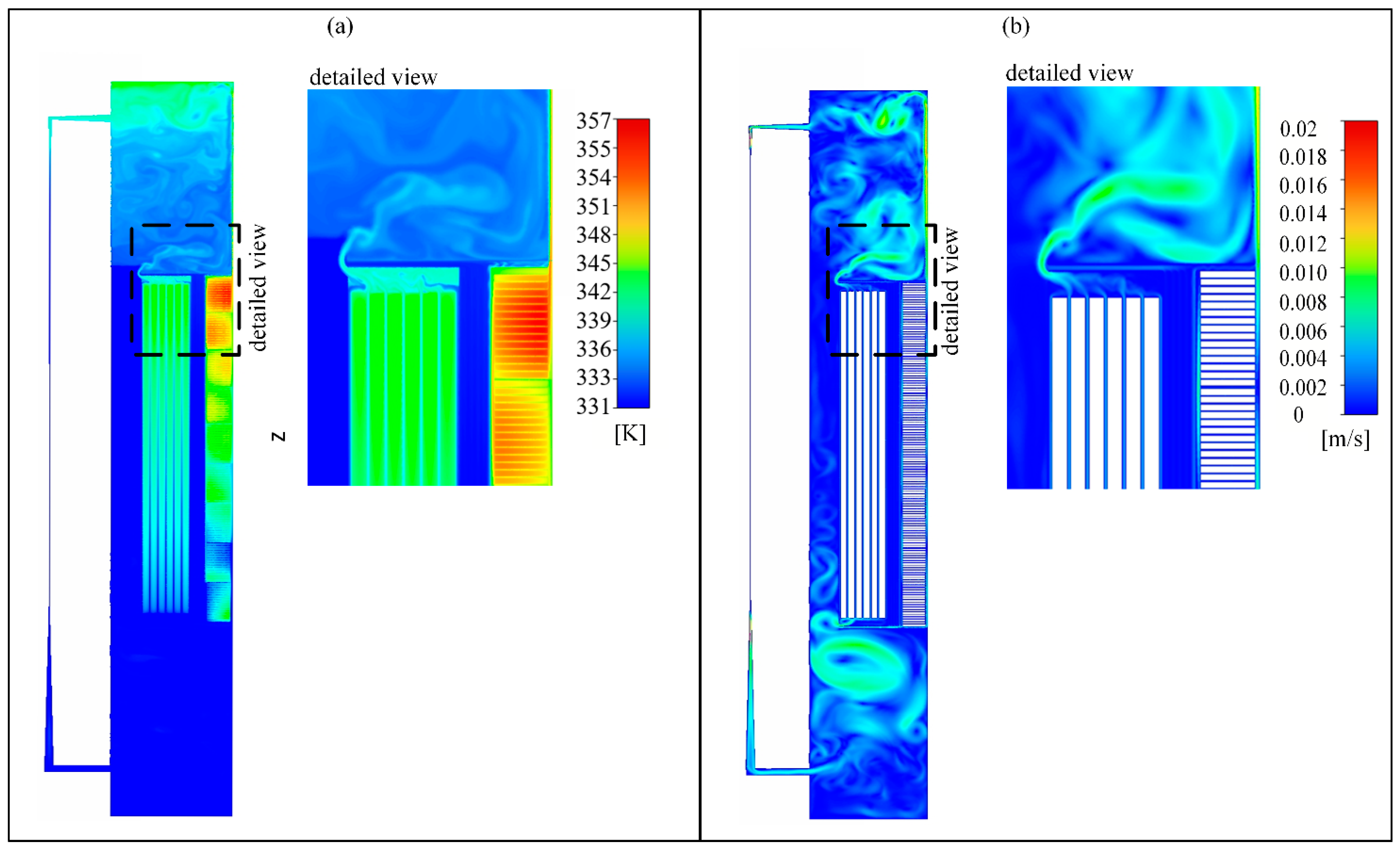
| Symbol | B | C | H | LHX | Lw | r1 | r2 | s1 | s2 | wHX | w1 | w2 |
|---|---|---|---|---|---|---|---|---|---|---|---|---|
| Value [mm] | 303.5 | 50.0 | 1100.0 | 667.0 | 493.1 | 668.5 | 694.0 | 21.2 | 21.2 | 1.3 | 5.0 | 2.0 |
| [kg s−1] | |||
|---|---|---|---|
| By-Pass | Wind. 1 | Wind. 2 | |
| Without heat generation | 0.58 | 0.0 | 0.0 |
| With heat generation | 0.17 | 0.32 | 0.09 |
| Description | Symbol | CFD | Simple Model | ||
|---|---|---|---|---|---|
| Top-liquid temperature rise [K] | 38.0 | 38.0 | |||
| Average liquid temperature rise [K] | 34.0 | 34.0 | |||
| Winding | 1 | 2 | 1 | 2 | |
| Wind. top-liquid temperature rise [K] | 37.0 | 52.7 | 36.4 | 53.0 | |
| Wind. average liquid temperature rise [K] | 33.5 | 41.4 | 33.2 | 41.5 | |
| Winding duct gradient [K] | gw | 12.3 | 8.0 | / | / |
| Winding gradient [K] | g | 11.8 | 15.4 | / | / |
| Average wind. temperature rise [K] | 45.8 | 49.4 | / | / | |
| Hot-spot temperature rise [K] | 50.9 | 60.5 | / | / | |
| Hot-spot factor [/] | H | 1.09 | 1.46 | / | / |
| Symbol | B | d2 | h2 | H | LHX | Lw,1 | Lw,2 | r1 | r2 | s1 | s2 | wHX | w1,o | w1,c | w1,i | w2,o | w2,i |
|---|---|---|---|---|---|---|---|---|---|---|---|---|---|---|---|---|---|
| Value [mm] | 0.9 | 2 | 9 | 3300 | 2000 | 1480 | 1540 | 556 | 418 | 21.2 | 78 | 1.25 | 6 | 5 | 6 | 7 | 6 |
| Description | Symbol | CFD | THN Model | ||||||
|---|---|---|---|---|---|---|---|---|---|
| Top-liquid temperature rise [K] | 38.0 | 38.0 | |||||||
| Average liquid temperature rise [K] | 34.0 | 34.0 | |||||||
| Liquid type | GTL | Syn. ester | GTL | Syn. ester | |||||
| Winding | 1 | 2 | 1 | 2 | 1 | 2 | 1 | 2 | |
| Wind. top-liquid temperature rise [K] | 37.7 | 52.1 | 41.4 | 61.6 | 39.0 | 54.0 | 42.8 | 64.1 | |
| Wind. average liquid temperature rise [K] | 33.9 | 41.1 | 35.7 | 45.8 | 34.5 | 42.0 | 36.4 | 47.4 | |
| Winding duct gradient [K] | gw | 4.9 | 2.7 | 5.1 | 2.8 | 4.5 | 2.2 | 4.9 | 2.0 |
| Winding gradient [K] | g | 4.8 | 9.8 | 6.8 | 14.6 | 5.0 | 10.2 | 7.3 | 15.4 |
| Average wind. temperature rise [K] | 38.8 | 43.8 | 40.8 | 48.6 | 39.0 | 44.2 | 41.3 | 49.4 | |
| Hot-spot temperature rise [K] | 43.8 | 55.6 | 47.9 | 65.3 | 43.0 | 56.0 | 47.0 | 66.0 | |
| Hot-spot factor [/] | H | 1.2 | 1.8 | 1.5 | 1.9 | 1.0 | 1.8 | 1.2 | 1.8 |
Disclaimer/Publisher’s Note: The statements, opinions and data contained in all publications are solely those of the individual author(s) and contributor(s) and not of MDPI and/or the editor(s). MDPI and/or the editor(s) disclaim responsibility for any injury to people or property resulting from any ideas, methods, instructions or products referred to in the content. |
© 2024 by the authors. Licensee MDPI, Basel, Switzerland. This article is an open access article distributed under the terms and conditions of the Creative Commons Attribution (CC BY) license (https://creativecommons.org/licenses/by/4.0/).
Share and Cite
Plaznik, U.; Breznik, B.; Prašnikar, B. Theoretical Study of Liquid Flow and Temperature Distribution in OF-Cooled Power Transformers. Energies 2024, 17, 571. https://doi.org/10.3390/en17030571
Plaznik U, Breznik B, Prašnikar B. Theoretical Study of Liquid Flow and Temperature Distribution in OF-Cooled Power Transformers. Energies. 2024; 17(3):571. https://doi.org/10.3390/en17030571
Chicago/Turabian StylePlaznik, Uroš, Blaž Breznik, and Borut Prašnikar. 2024. "Theoretical Study of Liquid Flow and Temperature Distribution in OF-Cooled Power Transformers" Energies 17, no. 3: 571. https://doi.org/10.3390/en17030571




